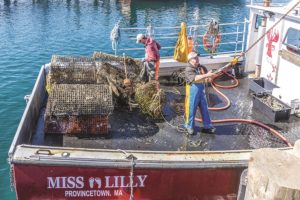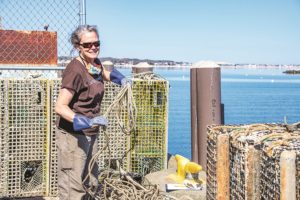PROVINCETOWN — Throughout April, a few hardy fishermen have been departing from MacMillan Pier most mornings not to haul in a bounty of fish but instead to haul in lost fishing gear.
Fishing in Cape Cod Bay is prohibited in March and April to protect the highly endangered North Atlantic right whales that gather here every spring to feed on concentrations of zooplankton in our cold waters. Fishermen could go out far beyond Cape Cod Bay, but at this time of year, most don’t, according to Laura Ludwig of the Center for Coastal Studies. Most boats are out of the water entirely in April, undergoing the maintenance and cleanup that will help them make better money in the fair summer months.
But now, every year, two to four boats and their crews stay wet so they can help with Ludwig’s Fishing Gear Recovery program. She writes the grant applications that pay their fuel costs, and they go out for eight hours at a time to locate lost lobster traps, crab traps, gillnets, and other “fixed gear” that’s become lost on the floor of Cape Cod Bay.
On April days when the sea is calm enough and winds are moderate, the contracted vessels leave the dock with a captain and at least one crew member, plus a naturalist who will record data throughout the day. The grappling equipment is supplied by the lobstermen, who know how to handle the heavy steel chains and tend the line draped over the boat’s hauling block while the boat makes slow concentric circles over promising areas.

Sonar is the tool that helps them know where to look, but after that it’s literally running a grapple along the seafloor, striking and bringing up trap after trap from the murky depths. Plastic, because it breaks down into microplastic fragments, is the material Ludwig says is of greatest concern. Ludwig says that derelict gear can entrap ocean life unnecessarily.
The program has brought up 38 tons of “ghost gear” since it began 10 years ago.
“Mike Rego, who owns the F/V Miss Lilly, named for his daughter, and also Rob Martin, who owns the F/V Resolve, have been doing this every year for years now,” said Ludwig. (For more about Rego, see page B3, “Tending the Bottom.”) Michael Russo of the F/V Adventure is also fishing out gear this April, Ludwig said. “There’s always at least one, maybe two more — it just depends who wants to do it,” she said. “What we can pay them is a tiny pittance compared to what they could make fishing offshore in the winter.”
About a third of the gear that’s hauled up is still usable, although reuniting it with its owners isn’t always easy. Most of the gear is truly lost — but some is conspicuously lacking in mandatory ID tags and may have been deliberately left out after the end of lobster season.
“We have surmised, based on construction style, age, and a couple of other factors, that a lot of the traps that come up without ID on them are recreational lobster traps,” said Ludwig. “It’s one of the major sources of ‘lost’ gear. Anyone can get a noncommercial lobster license; they’re $50. There are certain rules you’re supposed to follow. One is that your traps have to have an ID tag, and a buoy, and they’re supposed to be removed at the end of the season. We’re finding that doesn’t always happen.”

The Center for Coastal Studies reports back to the state on the sources of ghost gear. Thirty-eight tons of gear is a lot of data for fisheries managers. Provincetown’s DPW helps crush the unusable recovered fishing gear, and Nauset Disposal hauls it away for incineration.
Artists find a lot of the gear usable.
“For some reason, this year in particular, there’s a lot of interest in using this material for sculptural and artistic installations,” said Ludwig. “I’ve always tried to repurpose the plastic rope for doormats, but this year, for some reason, people have wanted nets. We don’t really grapple up a lot of nets. I’ve been reaching out to the mobile gear fishermen, draggers and scallopers and such, to help them dispose of nets they don’t need anymore.”
That artists are instinctively seeking out nets may be the most fitting response to this lockdown year there will ever be. Ludwig has secured an entire ton of such inspirational stuff to give to various artists. That’s in addition to five hundred pounds of raw material hauled up from the seafloor.
The only thing better than great art is a great year for whales.
“Our right whale aerial survey team saw eight mother-calf pairs on Saturday,” said Ludwig. “There was one year where there were no calves ever,” she said. That was 2018. “To see eight is just incredible.”
While 2021 has not changed the big picture for the endangered North Atlantic right whale species, at least it’s been a banner year in Cape Cod Bay.
Editor’s note: Because of a reporting error, an earlier version of this article identified Laura Ludwig as having seen eight mother-calf right whale pairs on April 24. It was the Center for Coastal Studies aerial survey team that saw the whale pairs.



